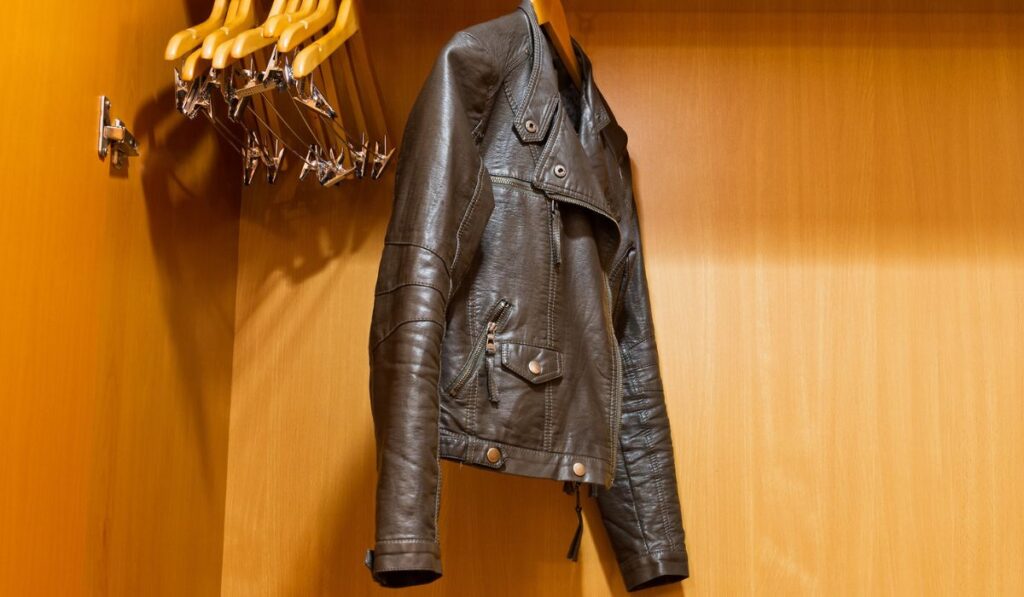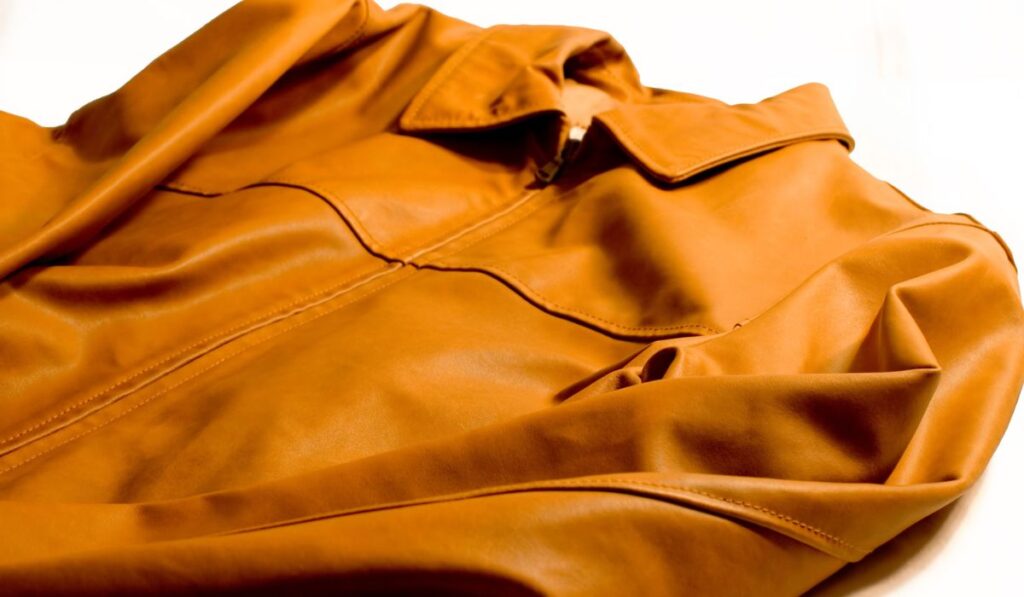A high-quality leather jacket is both stylish and protective. It can keep you warm in cold weather, and it can even protect you from rain. But leather jackets are costly, so you need to take good care of them.
A leather jacket shouldn’t be cleaned in a washer or dried in a dryer because it can warp, crack, or shrink. Instead, use a clean piece of cloth and dish soap, or a mixture of water and vinegar. After cleaning, hang the jacket to dry away from direct sunlight.
Let’s take a closer look at how to clean, dry, and condition your leather jacket. We’ll also go over how to remove stains from the jacket.
Can You Wash a Leather Jacket in a Washing Machine?

Leather jackets are a practical, cool addition to your wardrobe, although they can be relatively expensive. Nonetheless, leather jackets are tough and can last for many years if you take good care of them.
Unfortunately, these jackets can’t be cleaned in washing machines. Unlike other clothes, leather jackets can shrink or crack when thrown in the washer.
The rough tumble in the machines can even destroy your leather jackets beyond repair. If your leather jacket is dull or dirty, there are better ways of cleaning and treating them to ensure they look as good as new for a long time.
Drying a Leather Jacket
A leather jacket can offer you great protection when it’s raining, especially if you’ve treated it using a waterproof spray or wax (on Amazon). But as it rains, the leather will absorb some water. This is also the case after you wash the leather jacket. Whatever the case, you need to dry the jacket before using it again.
If the jacket isn’t soaked in water, you can simply wipe it with a dry towel, then hang it in an airy place to further dry before storing it.
But if the leather jacket is dripping wet, the best thing to do is to air dry it by hanging it on a hanger and leaving it to dry naturally. Never use a dryer to dry your leather jacket. Nor should you use a hairdryer to spot dry it.
Also, avoid drying the jacket in direct sunlight, as this might damage it. Just hang the jacket in a closet so it can dry slowly.
Other Methods for Cleaning a Leather Jacket
Never use a bleach-based cleaner or ammonia to clean your leather jacket. These chemicals can damage the finish, causing it to crack or get extremely dry.
Also, remember not to use too much water; doing so can cause staining. When you notice any spills or stains on your jacket, you should clean them as soon as possible using a soft piece of cloth.
Leather can absorb liquids because it’s porous, and when that happens, stains will form that are difficult to remove. Also, remember to keep sharp objects away from your leather.
To clean your leather jacket, follow the steps below:
- Mix some dish soap and water in a container. You can as well use a mixture of water and vinegar in a ratio of 1:1.
- Dip a soft piece of cloth into the mixture, wring it out to remove excess liquid, then use it to clean the jacket by wiping the stained areas.
- Once the piece of cloth gets dirty, you can put it aside and use another clean piece of cloth.
- Repeat this process until all the stains are removed. You can then use a clean towel to dry the jacket.
A very dirty jacket may need hand-washing. Before you wash it, remove everything in the pockets, then turn it inside out. Fill a bathtub or large sink with lukewarm water, then add a small amount of gentle detergent.
Agitate the water to get a relatively uniform mixture. Submerge the jacket in the water and swish it around to ensure the lining gets wet.
Gently squeeze the jacket and allow it to rest for about 10 minutes. If there are still some stains, use a soft bristle to rub them off. Remove the jacket from the water, drain off the dirty water, and fill the sink with clean water. Rinse the jacket thoroughly to remove all traces of the detergent. Finally, hang the jacket to dry.
Leather Jacket Conditioning
Once your leather jacket is cleaned and dried, you need to condition it. A leather conditioner (on Amazon) will prevent the jacket from excessively drying and eventually cracking.
Conditioning also protects the jacket against future stains. There are many leather conditioners on the market today. Just make sure you buy it from a trusted supplier.
You can make your own conditioner by mixing linseed and vinegar in a 2:1 ratio. Apply this mixture to your dry leather jacket and let it rest for 15 minutes. You can then use a soft cloth to clean off the excess mixture until your jacket shines.
To make your leather jacket last longer and look great, learn how to clean, dry, and condition it. Do not store the jacket before it’s thoroughly dried.
How to Remove Stains From a Leather Jacket
If your jacket has tough stains, the cleaning method discussed above may not remove them. To remove these tough stains, use any of the items discussed below:
Nail Polish Remover
If you have ink stains on your leather jacket, the best way to remove them is with a nail polish remover (on Amazon). Dip a cotton swab into the nail polish remover and use it to blot the stain gently.
Do not rub the cotton swab on the stain, as doing so could spread the stain to other areas. Once the stain is removed, use a clean, damp cloth to wipe the area clean, then dry using a towel.
Toothpaste
Toothpaste is another excellent stain remover — and it’s simple to use. Just use your finger to apply toothpaste on the affected area, then rub it gently with a soft piece of cloth.
Make sure you use a non-gel toothpaste and don’t scrub; otherwise, you might discolor or scratch the leather. Once you’ve removed the stains, wipe the area with a damp cloth.
Rubbing Alcohol
Rubbing alcohol (on Amazon) is among the chemicals you’re likely to already have at home. What you may not know, however, is that it’s an excellent chemical for cleaning leather products, particularly because it can eliminate mold and mildew from leather.
Mix one part water and one part rubbing alcohol in a container, then use it to dampen a clean piece of cloth. Rub the cloth gently on the affected area until you’re sure that the stain is removed. Wipe the area using another piece of cloth dampened with clean water.
Cornstarch or Baking Soda
Cornstarch and baking soda are excellent for removing grease or oil stains from leather. All you need to do is spread a pinch of baking soda or cornstarch on the stained area and rub gently using a damp piece of cloth.
Let the chemical sit overnight or for a few hours, depending on how tough the stain is. The starch or baking soda will absorb the grease or oil. Use a soft cloth to wipe the area, then dry with a towel.
Leather Jacket Care Instructions
A new leather jacket looks very neat and attractive when it’s new. Fortunately, it can maintain this attractiveness for many years, provided you take good care of it.
Here are a few tips on how you can maintain your leather jacket so it can serve you for many years while looking as good as new.
Use an Eraser (Flexible Putty) to Clean the Jacket

An artist’s eraser (on Amazon) is an excellent tool for cleaning leather jackets. If your jacket has mud that sponging can’t remove, use an eraser to remove it.
The advantage of flexible putty is that it crumbles as it picks up the dirt, meaning it can’t spread the dirt to clean areas. But even after using the eraser, you may need to wipe the area with a clean cloth.
Proper Storage
Leather isn’t like other fabrics that you can simply shove in a plastic bag and store for a long time. Leather must breathe for it to maintain its integrity.
That’s why leather jackets should be stored hanging in wardrobes where air flows freely and they’re not exposed to direct sunlight. It’s best to use a broad hanger that holds the jacket’s shoulders well.
Use a Leather Conditioner
As we mentioned above, a leather conditioner is key to your jacket care. But you must choose the right one. There are many sprays and waxes on the market today, and some can harm your leather jacket.
Check the care label on your jacket to know which conditioners are safe to use on it. Also find out which leather your jacket is made of: pigmented, aniline, nubuck, or suede. This can help you determine how best to care for your jacket.
